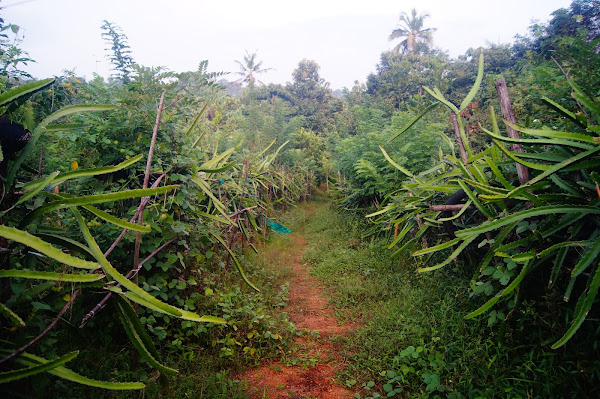10 most important tips to grow dragon fruits - Lessons from a Kerala forest farm
Successful Dragon Fruit Cultivation at Liz Pepper Gardens
A wildlife-co-existing farming technique that do not harm the wild
And at Liz Pepper Gardens in the lush forests of Kerala, we did a remarkable agricultural experiment. Here, the cultivation of dragon fruit, specifically the American Beauty variety, has flourished , and the wild-animals doesn't care despite the fruit being a sweet and tasty variety here, we get full yield without wildlife interruptions. Monkeys have taken over all the nearby fruit trees but not this one!!!
The key to this success lies in the plant's cactus-like characteristics that have discouraged wild animals from interfering with the plant.
A Natural Deterrent
The dragon fruit plant, with its vibrant green stems adorned with sharp spines, closely resembles a cactus. This similarity extends beyond appearances, as it serves as a formidable defense mechanism against wildlife intrusion. Wild animals often tend to avoid spiny and prickly plants, recognizing them as an unappetizing or potentially harmful food source. This natural deterrent has proven to be incredibly effective in protecting the dragon fruit crop.
**Ten Tips for Successful Dragon Fruit Cultivation in Kerala Forest Farms**
Here are ten valuable tips derived from the experience at Liz Pepper Gardens to ensure the successful cultivation of dragon fruit in forest farms, where wildlife may pose a threat:
1. Choose the Right Variety: Opt for dragon fruit varieties with cactus-like characteristics, as they are less appealing to wild animals.
2. Plant Spacing: Maintain adequate spacing between dragon fruit plants to allow for good air circulation and reduce the risk of pests and diseases.
3. Proper Soil Preparation: Ensure well-draining soil with a slightly acidic to neutral pH level for optimal growth. Here at Liz Pepper Gardens, we don't have modern tools, we use the mind power for now ( farmers here will understand this line )
4. Support Structures: Install sturdy trellises or supports to help the dragon fruit vines grow vertically, keeping the fruit away from potential ground-dwelling threats. So we take help of other strong small trees, we plant them along, unlike using any cement pillars on out plot.
5. Watering: Implement a regular but moderate watering schedule. Dragon fruit plants prefer slightly moist conditions.
6. Fertilization: Use organic fertilizers or compost to provide essential nutrients without attracting unwanted wildlife.
7. Sunlight: Dragon fruit requires full sun exposure, so ensure they receive adequate sunlight. Oh yes!!! they love the sun and this is why even if you have a sad dry land, you can make good use of it. Make it a plant yard!!!
8. Pruning: Regularly prune and trim the plants to encourage healthy growth and prevent overcrowding.
9. Pest and Disease Management: Keep a close eye on the plants for signs of pests or diseases and take prompt action if any issues arise. I saw a small snail last week on the branch and freaked out, so take notes here.
10. Harvesting: Harvest the fruit when it's ripe but still firm , don't keep waiting, the cool thing about the fruit is, it's gonna taste super sweet even when it's slightly pink ( we are talking about the taste of the variety we have at the forest farm )
By following these guidelines and capitalizing on the dragon fruit's cactus-like defenses, Liz Pepper Gardens has manage to unlock the secret to thriving dragon fruit cultivation in our Kulathupuzha forest farm. Check out for detailed cultivation updates coming soon!!!!!
Also read








Comments
Post a Comment